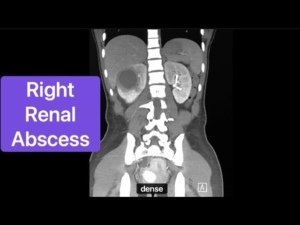Drainage Renal Abscess
To drain a large abscess causing low grade to high temperatures. Percutaneous or open procedure for the drainage of abscess.

Why is it done?
- Patients presenting with low grade persistent fevers, even high fevers requiring admission to High Dependency Unit for septicemia.
- Usually immune compromised patients: Diabetics, Corticosteroid users, Viral immune-deficiency states etc.
- This condition requires urgent drainage.
- The patients’ need to be resuscitated first by an emergency team with appropriate fluids and antibiotics and placed in an area where all systems can be supported (HDU).
- As soon as the patient is stable, this abscess needs to be drained, either with open surgery or percutaneous drain placement.
- If it is a large pyonephrosis with a non-functioning kidney, a nephrectomy should be considered.
How is it done?
 Patients will receive a general anesthesia.
Patients will receive a general anesthesia.- Appropriate resuscitation would have been started.
- Prophylactic anti-biotics is given.
- An indwelling catheter is placed.
- The correct kidney is identified and marked while you are awake.
- If it is a small abscess, an ultrasound guided needle is placed through your back or side into the fluid collection. A guidewire will be placed through the cannula and a drain fed in over the guidewire. All the pus will be drained.
- If it is a large loculated abscess, an incision will be made over the area closest to the skin. The cavity will be opened, drained and rinsed, after which a drain will be placed.
- If you have a non-functioning kidney associated with this, your kidney may be removed at the same time.
- A drain is left post-operatively.
What next?
- You will spend up to 7 or more nights in hospital.
- You may be on life support depending on the degree of sepsis.
- You will have intravenous fluids, antibiotics and circulatory supporting drugs being administered. Either a central venous line for monitoring, an arterial line and a peripheral infusion line.
- You will have a catheter for that time.
- A drain for 2-3 days.
- Your drain will be removed with minimal drainage present.
- You will a trial without the catheter as soon as you are back in the ward.
- You will be discharged as soon as your renal function has stabilized, and you have opened your bowels.
- Allow for 6 weeks for stabilization of symptoms.
- A follow-up appointment will be scheduled for 6 weeks.
- DON’T SUFFER IN SILENCE, OR YOU WILL SUFFER ALONE!
Risks
- This a potentially dangerous condition, which could result in death. It requires urgent management!
- May lose your kidney in serious cases.
- May risk dialysis when in septic shock.
- Wound Infection.
- Prolonged stay in HDU.
- Post-operative hernia formations especially associated in the elderly with atrophic abdominal muscles.
- NB! Each person is unique and for this reason symptoms vary
Download Information Sheet

Leave a Reply
Want to join the discussion?Feel free to contribute!